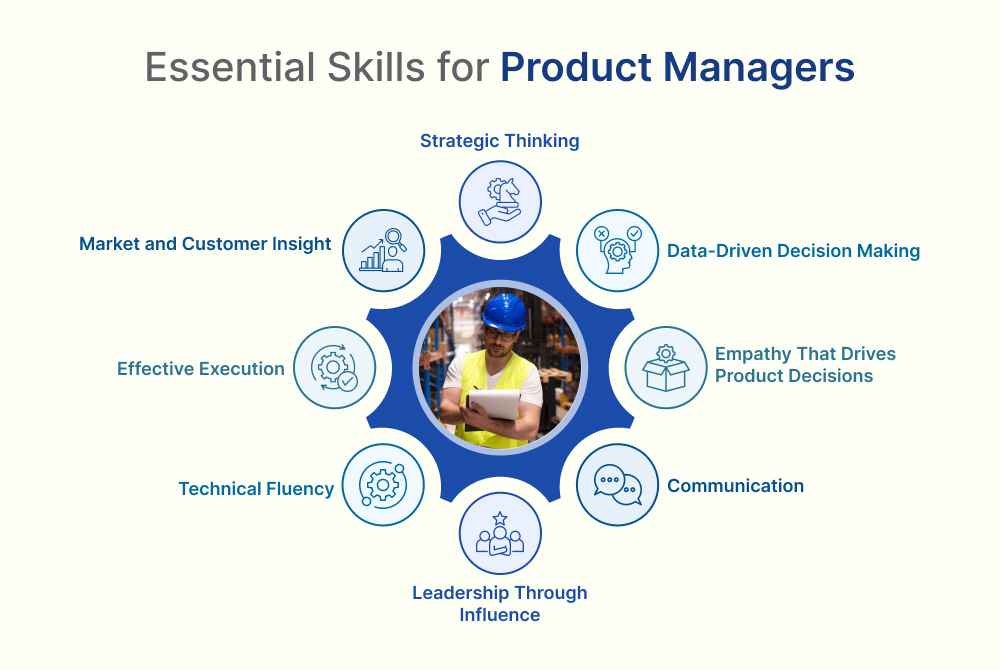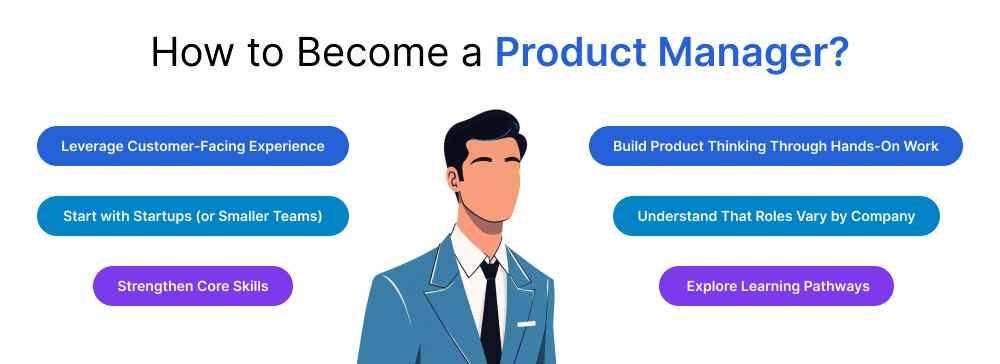
Behind every successful product is a Product Manager shaping the strategic direction and ensuring the product aligns with user needs and business goals. Whether it’s a new app feature, a physical product upgrade, or a complex platform overhaul, the product manager is responsible for aligning user needs, technical capabilities, and business goals into one cohesive product vision.
But what exactly does a Product Manager do? That’s a question many still find surprisingly hard to answer, not because the role lacks definition but because it spans strategy, execution, collaboration, and continuous improvement. From gathering insights and shaping product strategy to managing cross-functional teams and driving go-to-market success, PMs are the driving force behind a product’s entire lifecycle.
In this article, we’ll break down the key roles and responsibilities of a Product Manager, the essential skills that make them effective, the tools and collaborators they work with, and how the role adapts across different industries and career stages.
What is a Product Manager?
A Product Manager is the person responsible for guiding a product from concept to customer and beyond. Sitting at the intersection of business strategy, user experience, and technology, they ensure that the product being built not only solves real problems for users but also supports the company’s strategic goals.
At its core, product management is a strategic function. It involves understanding customer needs, analyzing market opportunities, setting a clear product vision, and aligning cross-functional teams, including design, engineering, marketing, and sales to bring that vision to life. However, the Product Manager doesn’t just hand off ideas to others; they remain involved throughout the entire product lifecycle, from ideation and development to launch, feedback, and iteration.
As part of their responsibilities, Product Managers translate business goals into actionable product decisions, prioritise features, coordinate releases, analyse performance metrics, and continuously refine the product based on user feedback. Whether it’s a physical product, digital app, internal platform, or a service-based solution, the PM’s responsibility is the same: deliver a product that adds value to both the user and the business.
In short, a Product Manager is not just a planner or project tracker; they are the visionaries, problem-solvers, and connectors who make great products happen.
Key Roles and Responsibilities of a Product Manager
Now that we’ve defined the overarching responsibilities of a Product Manager, let’s dive into the specific roles they play throughout the product lifecycle. From shaping the product vision to leading cross-functional teams, Product Managers ensure that every decision is aligned with both user needs and the company’s strategic intent. Their responsibilities cover everything from setting clear priorities to executing on strategies that drive product success and align with business goals.
But how do they do this in practice?
Let’s walk through the core responsibilities, not as a checklist, but as six overlapping zones of influence that define a PM’s day-to-day impact.
1. Crafting and Communicating a Meaningful Product Vision
At the heart of product management lies the product vision, a clear, purpose-driven statement that answers why the product exists and where it’s heading. A strong vision helps teams stay aligned, inspired, and focused.
This process begins by asking three deceptively simple questions:
- Why does the product exist?
- How will it achieve that purpose?
- What exactly is the product?
However, answering these questions effectively requires more than just surface-level answers. It involves collaborating with cross-functional teams to gather diverse perspectives, empathizing with the user’s pain points and needs, and applying strategic clarity to ensure the vision aligns with both customer expectations and business objectives. Product managers often lead vision workshops using frameworks like the “Why–How–What” bullseye to help stakeholders converge on a single, shared purpose.
In practice, crafting a product vision isn’t always straightforward. Product Managers often face tensions when aligning various stakeholders with the vision, especially when there are conflicting priorities or differing opinions. Balancing short-term needs with long-term goals can be challenging, and these disagreements may require the PM to make tough decisions. However, these discussions are essential for refining the vision and ensuring it resonates across teams.
Equally important is the role of feedback loops. As product development progresses, regular feedback from users and internal teams helps the PM refine and adapt the vision. This iterative process ensures that the vision remains relevant and continues to reflect the evolving needs of the market, while also adapting to new insights and opportunities. A good PM keeps this vision dynamic and responsive, regularly revisiting it to integrate feedback and adjust to shifts in user needs or market conditions.
A meaningful product vision also includes:
- Unique Value Proposition (UVP): What makes this product different, and why should people care?
- Target Persona Clarity: Who are we building this for? What are their core needs and pain points?
- Market Differentiation: How are we uniquely solving a problem that others haven’t addressed well?
- Strategic Alignment: Does this vision align with the organization’s long-term objectives?
Crucially, this vision is not static. A good PM regularly revisits and iterates it based on customer feedback, market shifts, or internal strategic pivots.
2. Understanding Customer Needs Through Empathy
One of the most critical responsibilities of a product manager is to deeply understand customer needs beyond what they say and beyond what analytics reports. This means developing a refined sense of empathy that allows the PM to connect with the customer’s motivations, frustrations, and behaviors at a human level.
Empathy, in the context of product management, is not just about hearing feedback or collecting feature requests; it is also about understanding the underlying needs and concerns of users. It’s about actively seeking to understand the why behind the customer’s choices, the trade-offs they make, and the emotional weight they carry in specific product interactions. A good product manager doesn’t just record problems; they internalize them and reflect them in every product decision.
To truly understand customer needs, Product Managers rely on several active techniques that go beyond surface-level feedback or analytics. Here are some core methods:
- Engage in Open-Ended Discovery
Product Managers conduct open-ended conversations with customers that go beyond simply validating pre-built ideas or features. These discussions are exploratory and centered on understanding users’ everyday challenges, goals, and environments. The goal is to uncover root causes that structured research might miss, giving PMs a broader perspective on what the customer truly needs. - Leverage Behavioral Analytics
PMs use behavioral data to identify patterns that users themselves may not be able to articulate. By analyzing how users interact with a product—whether they’re dropping off at certain stages or skipping features entirely—PMs can spot potential pain points and needs that haven’t been expressed through direct feedback. - Run Customer Interviews and Surveys
Though a more structured method, customer interviews and surveys remain essential for validating insights. The key here is to ask open-ended questions that allow customers to express their needs in their own words. This helps reveal both spoken and unspoken needs and deepens the PM’s understanding of user challenges. - Analyze Customer Support and Feedback Channels
Scrutinizing customer support tickets, reviews, and feedback forums can highlight recurring issues or requests. These sources are often rich in information about frustrations and missed opportunities, providing valuable clues that help PMs prioritize features that address customer pain points. - Conduct Usability Testing
Observing users interacting with a product in real-time helps Product Managers understand how users behave in context, rather than just what they report. Usability testing helps identify interaction bottlenecks or areas of confusion, offering insights into how the product experience can be improved. - Empathy Mapping
Using empathy maps, PMs build a comprehensive understanding of customers by mapping out their thoughts, feelings, pain points, and goals. This visual tool helps ensure that the PM always keeps the human side of the customer in focus during product development.
A product manager’s role in understanding customers is not passive; it’s active, deliberate, and deeply embedded in every decision they make. It’s not just a function of process but of mindset.
3. Defining Strategy and Prioritizing with Purpose
A Product Manager’s role goes far beyond backlog grooming or sprint planning; it’s about ensuring the product roadmap is both strategically sound and operationally achievable. This involves translating the long-term vision into a structured, dynamic strategy driven by clear prioritization.
At its core, this responsibility involves answering a difficult question daily:
“Among all the valuable things we could do, what must we do now to drive the biggest impact?”
To do this, Product Managers must balance multiple forces, including customer needs, technical feasibility, business goals, and market context, while rallying cross-functional teams behind a unified direction. Prioritization isn’t just a framework exercise; it’s the lens through which Product Managers filter out noise, balance competing demands, and maintain product momentum.
While Product Managers often struggle to find enough time for strategic work, research shows PMs spend 45% less time on strategy than they’d like; prioritization remains a core discipline of time management and product culture. Prioritization is about choosing what matters most and ensuring the focus stays sharp.
Executing the strategy involves:
- Applying customer-centric prioritization to ensure product decisions reflect user needs
- Using tools like Impact vs. Effort matrices and RICE scoring to balance development efforts
- Continuously reassessing priorities through agile principles, adapting quickly to changes in user feedback or market shifts
The best Product Managers operate like portfolio managers, allocating time and resources across different categories of work, including innovation, infrastructure, customer asks, and OKRs.
Techniques like Customer-Centric Prioritization, Innovation-Driven Planning, Outcome-Oriented Prioritization (OKRs), Enterprise Thinking, and KTLO (Keep the Lights On) aren’t just standalone tools, they are the product operating models that shape how the roadmap is constructed, evaluated, and evolved.
4. Building and Maintaining a Strategic Product Roadmap
Creating a compelling product roadmap is one of the most high-impact responsibilities of a product manager. It’s where strategic intent meets operational execution. But building a roadmap is not just about timelines and features; it’s about communicating priorities, aligning stakeholders, and enabling teams to act with clarity.
And yet, for many product managers, crafting a strategic roadmap feels like navigating a moving target. According to Gitnux, 65% of product managers consider roadmapping to be the most challenging task in their role. Balancing long-term vision with short-term priorities, while communicating clearly with diverse stakeholders, requires more than just tools; it demands strategic fluency, adaptability, and alignment.
To start, product managers evaluate potential initiatives through a structured lens:
- Customer needs and feedback
- Market shifts and competitor positioning
- Internal capacity and technical feasibility
- Strategic business goals and revenue potential
The result is not a static document but a narrative of how the product evolves to create value for both users and the business.
Just as important as building the roadmap is knowing how to present it. A product roadmap for an executive audience should focus on strategic themes and portfolio-level alignment. In contrast, a roadmap for delivery teams must connect to epics and user stories that fuel execution. Presenting the roadmap is a leadership moment for the PM to demonstrate that they’ve internalized the strategy, understood customer pain points, and can map the path to value delivery.
But a great roadmap isn’t “set and forget.” Markets shift, insights emerge, and assumptions change. That’s why product managers must treat the roadmap as a living artifact. Updating it regularly – monthly, bi-weekly, or as needed, ensures it reflects the latest learning and inspires trust from stakeholders. If your stakeholders start calling you for updates instead of consulting the roadmap, that’s a sign it’s out of sync.
To maintain roadmap credibility and value:
- Focus on clarity over complexity and tailor detail to the audience.
- Tie short-term sprints to long-term product vision.
- Revisit and revise regularly based on insights from discovery and delivery.
- Make it easily accessible, visible, and actionable.
Ultimately, the roadmap is a shared compass, not just a schedule. The product manager is its steward, keeping it honest, adaptive, and aligned to the ever-evolving reality of user needs and business ambition.
5. Driving Product Releases and Market Readiness
Shipping a product is more than simply flipping a release switch; it’s the culmination of strategic alignment, rigorous execution, and cross-functional coordination. Product managers act as the orchestrators of this launch ecosystem, ensuring every moving part comes together to deliver a seamless user experience at launch.
Yet, launch anxiety is real – 39% of product managers express concern about missing launch dates, reflecting the high-stakes coordination required across teams. Aligning development speed with go-to-market precision remains a persistent challenge, particularly in rapidly evolving product environments.
At this stage, the PM’s job is twofold:
- Drive internal readiness by aligning engineering, marketing, sales, and customer support around timelines, feature scope, and positioning.
- Ensure market readiness by anticipating how users will adopt, perceive, and interact with the new release.
Key responsibilities include:
- Final QA coordination with engineering to validate functionality and fix critical issues.
- Sales enablement through demos, feature breakdowns, and guidance on handling objections.
- Customer onboarding flows are designed in tandem with CX and product design to drive engagement from day one.
- Marketing asset signoff, including launch messaging, landing pages, and promotional plans.
Product managers must also choose the right launch strategy:
- A phased rollout helps mitigate risk, letting the team validate performance and UX with a smaller user base before scaling.
- A “big bang” release offers rapid impact and broader visibility but demands precision and organisational alignment at all levels.
After launch, the real work begins. Product managers closely monitor adoption metrics, usage patterns, and system performance to detect friction points and spot opportunities for quick wins.
This includes:
- Analysing retention drop-offs and churn signals
- Reviewing activation rates and time-to-value
- Collecting qualitative feedback through support tickets, surveys, and customer interviews
A product manager’s launch success isn’t judged solely by whether the release went live; it’s measured by whether the product delivered value and is learning-ready for iteration. In high-performing teams, the launch isn’t a finish line; it’s a learning loop.
6. Orchestrating Cross-Functional Collaboration
Product development is not a solo act; it’s a collaborative production. Product managers serve as the conductors, bringing together diverse functional teams into a unified rhythm that delivers real user value. This orchestration is less about authority and more about alignment, empathy, and shared ownership.
At its core, cross-functional collaboration in product management involves uniting specialists from engineering, design, marketing, sales, customer success, and legal to contribute their unique expertise toward a single goal: building a product that works, resonates, and performs effectively.
Just as a successful potluck requires each guest to bring a unique dish, great product outcomes rely on each team bringing their “best recipe” to the table. Designers bring usability and visual intuition. Engineers deliver performance and feasibility. Marketers craft positioning. Legal ensures compliance. The PM’s job is to ensure that all contributions are not only present but also complementary to one another.
Key responsibilities for product managers include:
- Creating a shared understanding of product goals and success metrics
- Facilitating transparent communication across teams through rituals like standups, sprint planning, and roadmap reviews
- Balancing trade-offs between desirability, feasibility, and viability during decision-making
- Resolving conflicts that arise from competing priorities or siloed workflows
- Ensuring everyone sees the bigger picture, not just their slice of work
Cross-functional teams work best when they are self-sufficient yet interdependent, where each member owns their domain but is open to feedback, iteration, and integrated thinking. As organisations scale, this collaboration becomes increasingly complex. PMs must foster psychological safety and trust so that teams can challenge assumptions, share roadblocks, and co-create impactful solutions.
In this role, you don’t just manage tasks. You enable collective momentum, turning diverse talent into a focused force that delivers value together.
Essential Skills for Product Managers
Product managers aren’t just task organisers; they’re connectors, interpreters, problem-solvers, and sometimes even peacekeepers. To navigate the crosswinds of business expectations, user needs, and delivery constraints, they need more than just a checklist of competencies. They need a blend of mindset, methods, and mastery across disciplines.
1. Strategic Thinking
Every roadmap, backlog, and feature request must be evaluated in the context of a bigger picture. The best PMs don’t just ask, “What do we build next?” They ask, “Where are we headed, and why does this matter now?”
This involves tracking evolving market signals, identifying trends early, and determining where the product aligns with the company’s growth strategy. It’s not just vision-setting; it’s scenario planning, trade-off modeling, and long-term value creation.
2. Data-Driven Decision Making
Some PMs collect data to justify what they already believe. Great PMs use data to challenge assumptions.
Whether it’s parsing through user funnel drop-offs, correlating feedback with feature adoption, or spotting a usage trend buried in a dashboard, PMs must have the curiosity and competence to let data guide them, not blind them. This isn’t about being a data scientist; it’s about asking better questions and knowing when the numbers don’t tell the full story.
3. Empathy That Drives Product Decisions
Empathy is not about being nice. It’s about being accurate. PMs need to understand not just what users say but what they feel, avoid, and expect.
For example, a customer complaining about a “slow app” may be seeking emotional reassurance during a high-stakes transaction. PMs must develop the ability to hear beyond words and decode intent. This is what differentiates a useful feature from a delightful one.
4. Communication
Every stakeholder speaks a different language. Engineers want clarity, executives want outcomes, designers want context, and customers want confidence. The PM is the one who translates fluently in all directions.
This means storytelling, negotiation, synthesis, and occasionally saying “no” in a way that still feels like alignment. A roadmap that no one understands isn’t a strategy; it’s a liability.
5. Leadership Through Influence
Product Managers must possess the skill to lead through influence rather than authority. This involves rallying cross-functional teams, making tough decisions under pressure, and aligning team members around shared goals and priorities. Effective PMs inspire others by providing clarity, empathy, and conviction in their decision-making. They guide teams through uncertainty and ensure that everyone is working toward the same vision, driving the product forward even when formal leadership structures are not in place.
| 69% of professionals view product management as a leadership role, even though most PMs don’t manage people directly. This reflects the increasing expectation for PMs to lead through clarity, empathy, and conviction, not hierarchy. |
PMs are judged by the outcomes they drive, not the headcount they manage.
This includes rallying the team during ambiguity, holding the line on priorities under pressure, and making tough calls when the direction is unclear. Leadership for PMs is a day-to-day posture, not a designation.
6. Technical Fluency: Speaking Engineer Without Pretending to Be One
You don’t need to code. However, you do need to understand what is technically feasible, what is challenging, and what seems simple but is not.
Only 5% of product managers know how to code, yet the best PMs develop a working knowledge of APIs, architecture, and engineering trade-offs.
Technical fluency isn’t about writing code, it’s about asking better questions, anticipating risks, and making collaborative decisions with developers.
A product manager who can’t speak the basic language of APIs, integrations, data models, or system constraints often becomes a bottleneck.
7. Effective Execution
Product Managers need the skill to execute the product vision efficiently. This involves managing scope, timelines, and quality assurance while ensuring the product is delivered on time and meets user expectations. PMs rely on tools like JIRA boards, release calendars, and UAT checklists to keep things organized and ensure the product reaches the market smoothly. The goal is to stay focused on the product’s core purpose while addressing the logistical challenges that come with delivery.
8. Market and Customer Insight: Beyond Personas and Surveys
Understanding your customer goes beyond demographics and NPS scores. It’s about knowing what they’re trying to achieve, what’s broken in their workflow, and why they would or wouldn’t choose your product again.
A great PM becomes fluent in the customer’s world, how they think, what pressures they face, and where your product fits into their personal or professional success.
How to Become a Product Manager?
Breaking into product management doesn’t require a single linear path, but it does demand curiosity, strategic thinking, and a deep interest in solving user problems. Here’s how aspiring PMs can start their journey:
1. Leverage Customer-Facing Experience
You don’t need to start with the product to end up with the product. Many skilled product managers start their careers in adjacent roles such as sales, customer support, marketing, or business analysis.
These roles offer a front-row seat to customer frustrations, expectations, and usage patterns, an advantage that helps PMs prioritize not just what users want, but what they truly value.
| 42% of product leaders report that customer demands to retain older features make it difficult to introduce new ones. |
Firsthand experience with users can help product managers strike a better balance between legacy expectations and forward-looking innovation.
If you’re currently in any of these functions, seek opportunities to collaborate with product or design teams, contribute to product documentation, or participate in user research. This exposure builds the empathetic muscle and market fluency that technical knowledge alone can’t substitute.
2. Build Product Thinking Through Hands-On Work
Practical experience matters. While certifications can signal credibility, nothing builds product instincts like actually working on product-related initiatives. Volunteer to assist with feature launches, manage a beta release, or coordinate user feedback loops. Get comfortable with tools like Jira, Trello, Notion, or Figma to understand how modern product teams operate
Side projects, such as building a small app, running an e-commerce experiment, or even improving internal workflows, can demonstrate initiative and a product mindset.
3. Start with Startups (or Smaller Teams)
If you’re starting, junior product roles in startups or smaller firms are often more accessible than those in large enterprises. Startups value curiosity, adaptability, and a learning mindset more than polished résumés.
You’ll likely wear multiple hats, working across UX, engineering, customer success, and marketing. While the environment can be intense, it accelerates your growth and provides you with full visibility into the product lifecycle.
4. Understand That Roles Vary by Company
The title “Product Manager” can mean different things depending on the company.
- In smaller organizations, PMs handle everything from discovery to delivery.
- In mid-sized companies, you might work alongside product owners, business analysts, and UX researchers.
- In larger tech firms, there are often specialized roles, including platform PMs, growth PMs, technical PMs, and more.
- Understanding these variations helps you tailor your applications, conversations, and expectations accordingly.
5. Strengthen Core Skills
Regardless of company size, there are a few foundational skills that every aspiring PM must develop:
- Customer empathy: Understand not only what users want but also why they want it.
- Strategic thinking: Connect feature ideas to broader business and user goals.
- Collaboration: Work fluidly with design, engineering, marketing, and operations.
- Data literacy: Use both qualitative and quantitative insights to drive decisions.
- Communication: Articulate problems, decisions, and roadmaps to stakeholders.
Yet, many organizations still see skill gaps in their product teams. According to the report Challenges in Product Management, 56% of respondents rated their product managers’ skills as average or below average, suggesting a strong need for continual development in these core areas.
Mastering these skills isn’t just about checking boxes, it’s about becoming the connective tissue between vision and execution, users and business, strategy and delivery.
6. Explore Learning Pathways
While on-the-job learning is key, formal programs can help accelerate your entry into the field. Structured courses, such as Certified Scrum Product Owner (CSPO), design thinking workshops, or product management boot camps, offer frameworks, tools, and peer communities to build your capabilities and expand your network.
Becoming a product manager isn’t just about landing the title; it’s about building the mindset. It’s a role that combines empathy, execution, and strategy. Start by immersing yourself in customer problems, building small wins, and collaborating across functions. With persistence and curiosity, you’ll find your path into the product world, and once you’re in, the opportunities are endless.
Conclusion
The role of a product manager is as dynamic as the products they help shape. From discovering user pain points to delivering high-impact features, product managers sit at the intersection of strategy, design, technology, and business. But beyond tasks and tools, great PMs bring vision, empathy, and clarity to every conversation, rallying cross-functional teams to solve real problems with purpose.
There’s no universal definition of what a product manager does because no two products or companies are the same. In some places, the PM is a strategist and visionary. In others, they’re a tactician, analyst, or collaborator-in-chief. However, regardless of the setting, their influence extends to every part of the product journey.
If you’re considering this path or just stepping into the role, remember that you’re not simply building features; you’re also building a team. You’re enabling outcomes. You’re shaping experiences. You’re driving business value while keeping the customer at the center.
And while the road may be complex, it’s also incredibly rewarding, offering opportunities to lead, learn, and grow in ways few other roles can.






















